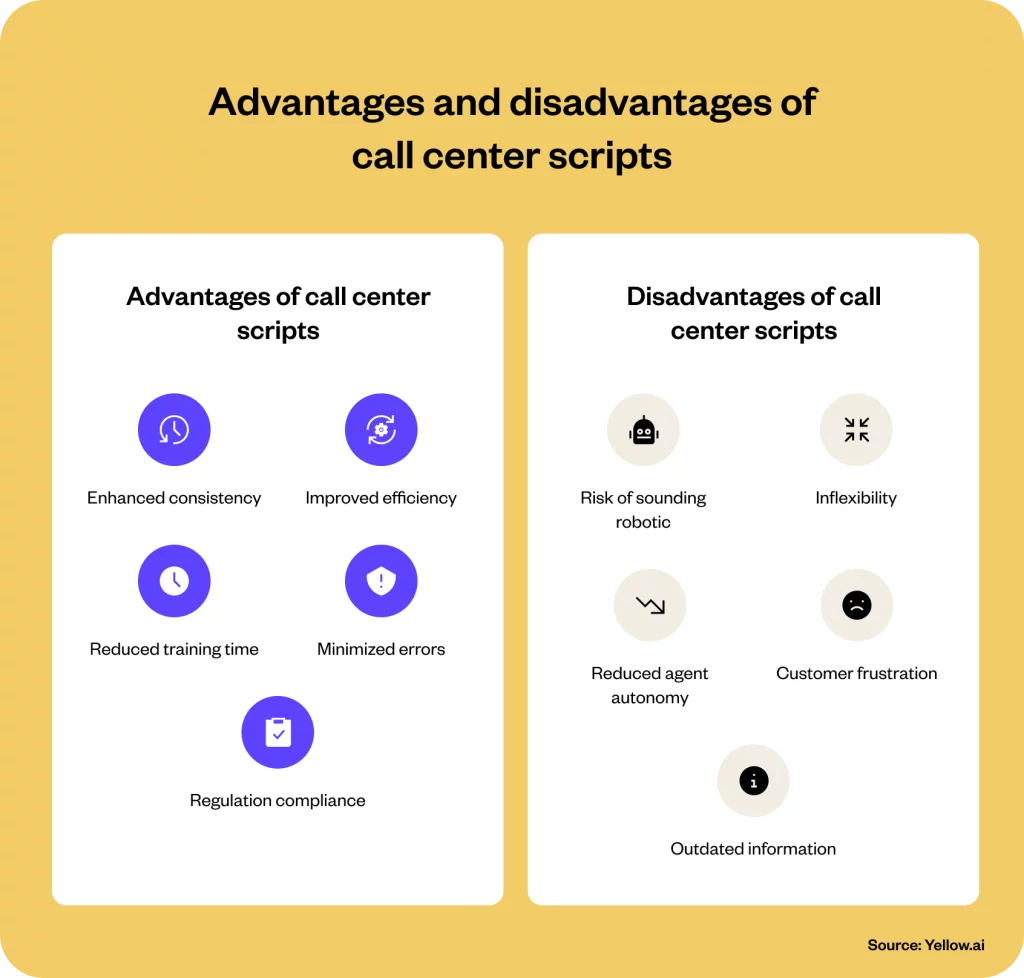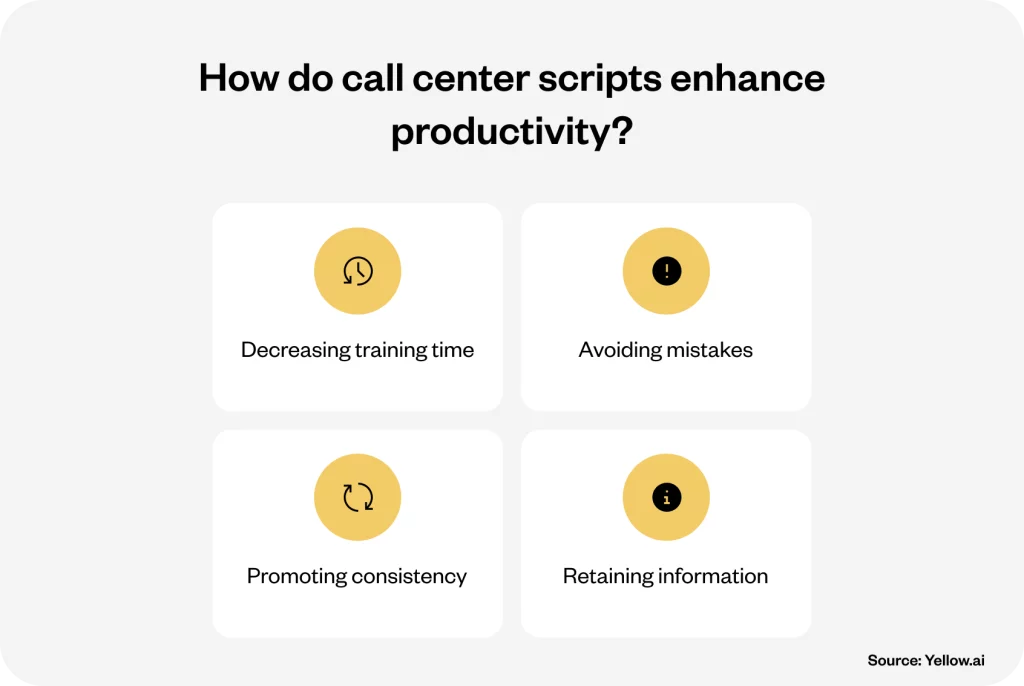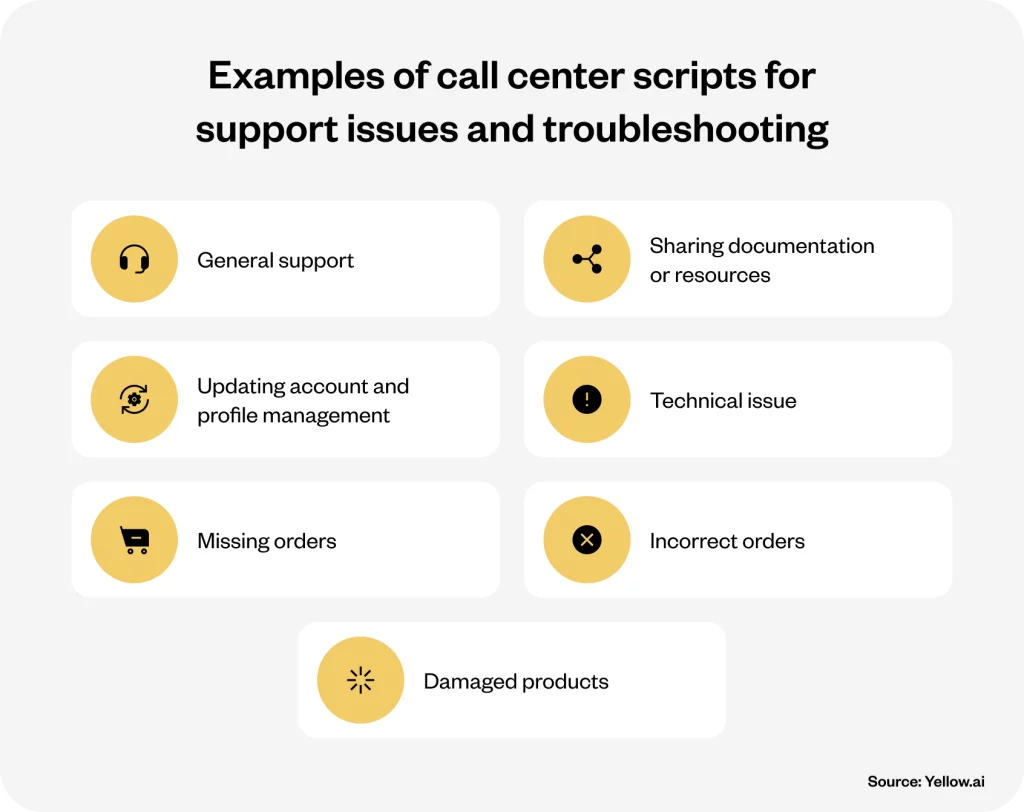Executive summary
Call center scripts are the unsung heroes in today’s customer service environment. These scripts empower agents to navigate through conversations with confidence and empathy. This blog explores the essence of call center scripting and sheds light on its pivotal role in shaping memorable customer interactions. We share practical insights on call center script samples, best practices, and the transformative impact of innovative technologies. This blog will equip businesses with the knowledge to craft scripts that answer calls and also build connections, ensuring every customer feels heard, understood, and valued.
Step into a day in the life of a call center agent: a role filled with unpredictability and the chance to make or break a customer’s day. Here, the secret weapon is not merely a friendly voice or quick thinking. Instead, it is the call center script. Far from being a rigid set of lines, today’s call center scripts are the backbone of dynamic, empathetic customer interactions. They are the cheat sheet that empowers agents to navigate through calls with confidence, offering tailored solutions that feel anything but scripted.
According to a 2022 survey by Gartner, by 2026, around 10% of agent contacts will be automated worldwide, and conversational AI contact center deployments will save $80 billion in agent labor expenses. In a world where digital communication often overshadows personal touch, call center scripts are a testament to the power of personalized interaction. Imagine a scenario where every customer, with their unique story and problem, finds more than just a solution. Here, customers find a connection on the other side of the line. It is the potential that a well-crafted script holds. It is not merely about resolving issues. Instead, it is about weaving a narrative of care, understanding, and trust with each word spoken.
As we explore call center scripts, we are focusing on the mechanics and the art of turning routine customer service calls into memorable experiences that resonate with empathy and effectiveness.
Related must-reads:
- Call center agents – Responsibilities, skills & challenges
- Call center software – A Complete Guide [2024]
- Cloud contact centers: Transforming customer service
What is a call center script?
Call center scripts are guides that help agents communicate effectively with customers. They outline what to say in different situations. It ensures consistency and clarity across all customer interactions. Think of them as roadmaps for conversations that allow agents to navigate through calls with confidence. These scripts include greetings, responses to common questions, and solutions to typical problems. These scripts are tailored to fit the company’s voice and customer service strategy.
The value of a call center script lies in its ability to make complex customer service scenarios manageable for agents. It is not merely about sticking rigidly to a script. Instead, it is about having a reliable reference point that agents can adapt to fit the flow of each unique conversation. This adaptability ensures that interactions remain personal and engaging rather than mechanical. Scripts also help new agents get up to speed quickly, reducing training time and improving overall service quality.
In practice, a well-crafted call center script is a combination of structure and flexibility. It supports agents in delivering service that feels professional and personal. By providing clear guidelines, scripts help avoid misunderstandings and ensure that customers receive the help they need efficiently. Besides improving customer experience, this approach also boosts agent confidence and performance. That makes call center scripts a crucial tool in the customer service toolkit.
Advantages and disadvantages of call center scripts
Customer interactions with call center scripts offer advantages and disadvantages that businesses must consider carefully. Let’s explore what makes them both beneficial and challenging.

Advantages of call center scripts
- Enhanced consistency: Call center scripts ensure that every agent delivers the same level of service and information. It provides a uniform experience to customers that builds trust and reliability in your brand.
- Improved efficiency: With predefined responses at their fingertips, agents can significantly reduce resolution times. It allows them to assist more customers in a shorter span. Subsequently, it boosts overall productivity.
- Reduced training time: Scripts are an excellent training resource for new agents. Scripts offer them a solid foundation of how to handle common queries and situations. It speeds up the onboarding process.
- Minimized errors: By adhering to a call center script, agents are less likely to provide incorrect information. It ensures that customers receive accurate and reliable support.
- Regulation compliance: In industries where regulatory compliance is crucial, scripts help maintain adherence to legal standards. Since scripts guide agents on what can and cannot be said during interactions, the agents can simply adhere to the legal standards.
Disadvantages of call center scripts
- Risk of sounding robotic: Over-reliance on scripts can make conversations feel impersonal and scripted. It can potentially alienate customers who seek a more human touch in their interactions.
- Inflexibility: Scripts may not cover every unique customer scenario. That can leave agents ill-equipped to handle atypical questions or problems that deviate from the script.
- Reduced agent autonomy: Strict adherence to scripts can stifle agents’ ability to use their judgment and creativity to solve complex issues. It can potentially lead to customer dissatisfaction in situations that require a personalized approach.
- Customer frustration: Customers who encounter agents strictly following scripts may feel their specific needs and concerns are not being fully acknowledged or addressed. It can lead to frustration.
- Outdated information: Scripts need regular updates to reflect changes in policies, products, or services. Failure to do so can result in agents providing outdated or incorrect information to customers.
How do call center scripts enhance productivity?
Call center scripts are more than just a guide for conversation. They are tools that boost productivity in several vital ways. Let’s explore how these scripts make a difference in everyday operations.

1. Decreasing training time
Training new agents is a significant investment. Call center scripts speed up this process by providing clear examples of how to handle various customer interactions. This direct approach helps new agents get up to speed quickly. Hence, it reduces the need for prolonged training sessions. As a result, agents can start contributing to the team’s goals sooner, and experienced agents can focus more on their work rather than training newcomers.
2. Avoiding mistakes
Scripts help agents avoid common errors by outlining the correct procedures and responses. It is crucial to ensure that customers receive accurate information and solutions. By following a script, agents are less likely to make mistakes that could lead to customer dissatisfaction or the need for additional calls to resolve an issue. Besides saving time, it also maintains the quality of service.
3. Promoting consistency
One of the most significant advantages of using scripts is the consistency in customer interactions. No matter which agent a customer talks to, they receive the same level of service and information. This consistency helps build trust and reliability in your brand. It also ensures that customers have a positive experience every time they reach out for support or information.
4. Retaining information
For sales calls, capturing important customer details is critical. Scripts often include prompts for agents to collect and note down specific information during a call. It ensures that nothing important is missed and the information is available for future reference. It helps in providing personalized service and follow-ups. It subsequently increases the chances of selling or solving a customer’s problem effectively.
Examples of call center scripts for greeting and opening conversations
First impressions are crucial, especially in call centers where each interaction can significantly impact customer satisfaction and loyalty. A well-crafted greeting script sets the stage for a positive dialogue. It reassures the caller that they have reached a professional and caring organization ready to address their needs. Below, we explore various scenarios call center agents might encounter and provide examples for each approach.

1. General inquiries
For callers reaching out with general questions, a warm and open-ended greeting invites a conversation without assuming the caller’s needs. It is about striking a balance between professionalism and approachability.
Here are some examples:
“Good [morning/afternoon/evening]! You have reached [Company Name], where we love to help. What can I assist you with today?”
“Hello, and thank you for calling [Company Name]. I am [Agent’s Name], how may I direct your inquiry?”
“Welcome to [Company Name], your one-stop for all queries. How can I make your day better?”
2. New customers
New customers are at the beginning of their journey with your brand. The script should convey excitement and a welcoming tone. It will make them feel valued and confident in their choice.
Here are some examples:
“Welcome to the [Company Name] family! I am [Agent’s Name], here to ensure your first experience is fantastic. What brings you to us today?”
“Hello and congratulations on choosing [Company Name]! We are thrilled to have you. How can we start this journey together?”
“A big welcome from all of us at [Company Name]! What can I do on this fine day to assist you?”
3. Tenured customers
Recognizing and appreciating returning customers fosters loyalty and a personal connection. This script acknowledges their ongoing relationship with your brand.
Here are some examples:
“It is always a pleasure to assist a valued member of our [Company Name] family. What can I help you with today?”
“Welcome back to [Company Name]! Your continued trust means the world to us. How may I serve you today?”
“Hello again, and thank you for your loyalty to [Company Name]. What’s on your mind today that I can assist with?”
4. Unhappy customers
Dealing with unhappy customers requires empathy and a swift, solution-oriented approach. The script should immediately acknowledge their feelings and move toward resolution.
Here are some examples:
“I’m truly sorry to hear you are having a tough time. Let’s work together to make things right. Can you tell me more about what happened?”
“I understand how frustrating this must be, and I apologize. Let’s find a solution together. Could you give me more details?”
“I’m here to help with any issues you’re facing. Let’s get to the bottom of this so you can get back to enjoying our services.”
5. Holds and transfers
Placing a caller on hold or transferring them can be a friction point if not handled delicately. The script should reassure the caller that their issue is being prioritized.
Here are some examples:
“May I have a moment to look into that for you? I’ll be as quick as I can. Thank you for your patience.”
“I want to connect you with the best person to help. Can I put you on hold for just a moment while I make that happen?”
“To ensure you get the detailed assistance you need, I’m going to transfer you to our [specific department]. They’ll be with you shortly.”
Examples of call center scripts for support issues and troubleshooting
Addressing support issues and troubleshooting requires a careful balance of empathy, efficiency, and expertise. The goal is to make customers feel supported and valued, even in the face of problems. Below, we outline scripts designed to navigate these complex interactions with grace. These scripts will guide agents through resolving technical issues and also help maintain a calm and helpful demeanor throughout.

1. General support
General support calls are often the first touchpoint for customers seeking help. A script that starts with a warm, open-ended question can make customers feel welcomed and heard.
Here are some examples:
“Thank you for calling [Company Name]’s support. How can we make your day better?”
“Hello, you have reached [Agent’s Name] at [Company Name] support. Tell me, how can I assist you today?”
“Welcome to [Company Name], where your satisfaction is our priority. What issue can I help you resolve today?”
2. Sharing documentation or resources
Directing customers to the right resources empowers them to find answers quickly and efficiently. It will save time for both the customer and the agent.
Here are some examples:
“It sounds like our guide on [Topic] could be really helpful for you. Would you like me to email it to you?”
“I have a detailed tutorial that can walk you through this step-by-step. Shall I send it over?”
“We’ve got a comprehensive FAQ section that covers this. I can guide you there if you’d like?”
3. Updating account and profile management
Handling personal information requires a script that reassures customers about their privacy while efficiently addressing their needs.
Here are some examples:
“I can help you with updating your account details. May I verify your account info first for security purposes?”
“To update your profile, I’ll need to ask you a couple of security questions. Ready when you are.”
“Let’s get your account information updated. I’ll guide you through the process step by step.”
4. Technical issue
Technical issues can be frustrating. Scripts should aim to calm the customer and assure them that a solution is on the way.
Here are some examples:
“Let’s tackle this technical issue together. Could you describe what you’re experiencing?”
“I’m here to help with your technical problem. Can you tell me exactly what happened before the issue started?”
“Technical troubles can be frustrating. Let’s get some details and see how we can fix this for you.”
5. Missing orders
Missing orders create anxiety and disappointment. Your script needs to express empathy and take immediate action to locate the order.
Here are some examples:
“I understand your concern about the missing order. Let me look into this right away for you.”
“Missing your order is not the experience we want for you. I’m on it—let’s find out where it is.”
“Let’s track down your order together. May I have your order number to start the investigation?”
6. Incorrect orders
Receiving the wrong item impacts the customer’s experience. A script focused on quick resolution and apology can help rectify the situation.
Here are some examples:
“Receiving the wrong item is disappointing, and I’m sorry about that. Let’s make it right.”
“I apologize for the mix-up with your order. We’ll start the process for a correct replacement now.”
“That’s not what we like to hear. Let’s get the correct order to you as soon as possible.”
7. Damaged products
Damaged products are a direct reflection of your brand. Offering a swift and empathetic response is crucial to maintaining trust.
Here are some examples:
“I’m really sorry to hear your product arrived damaged. We’ll sort out a replacement or refund for you.”
“Your product shouldn’t arrive damaged. Let’s get this resolved—would a replacement or a refund work better for you?”
“Damage is unacceptable, and I apologize. Let me take care of this for you right now.”
Examples of call center scripts for ending conversations
Ending a call positively, regardless of the issue’s resolution, leaves a lasting impression on the customer. It’s your opportunity to affirm the value you place on their satisfaction and feedback.

1. Successfully resolved an issue.
Concluding a call after a successful resolution reinforces the positive outcome and leaves the door open for further assistance.
“I’m glad we could resolve this for you today. Is there anything else I can do to assist?”
“Happy we could help. Remember, we’re here whenever you need us. Have a great day!”
“It’s been a pleasure assisting you. Feel free to reach out for any more help.”
2. Customers who are still angry
Acknowledging the customer’s ongoing frustration and offering additional support can mitigate negative feelings and demonstrate your commitment to their satisfaction.
“I understand your frustration and truly wish we could’ve done more today. Your feedback is valuable and will be used to improve our services.”
“I’m sorry we couldn’t fully meet your expectations this time. I’m here to listen if you have more to share.”
“It seems we still have some work to do. I assure you, your concerns will be escalated and addressed.”
3. Unresolved issues
When issues can’t be resolved in one call, setting clear expectations for the next steps is essential to maintaining trust.
“We’re still on it, and I promise we’ll keep you updated every step of the way. Can we reach out via email or phone with updates?”
“I understand how important this is to you, and we’re making it our priority. Let’s set a follow-up time that works for you.”
“I’m sorry we couldn’t solve this today, but we’re not giving up. Your issue has been escalated, and we’ll be in touch with updates.”
4. Requesting customer feedback
Asking for feedback shows you value the customer’s opinion and are committed to continuous improvement.
“Your insights help us serve you better. Would you be willing to share your experience today through a quick survey?”
“We hope we’ve met your expectations. Could we send you a short survey to learn how we did?”
“Feedback is a gift, and we’d love to hear from you. May we email you a brief survey about today’s call?”
How Yellow.ai can revolutionize your call center operations?
Transitioning seamlessly from traditional call center scripts to the dynamic world of AI-driven and automated customer service, Yellow.ai is your best ally in transforming customer interactions into memorable experiences. Imagine a platform where AI chatbots and human-like voice AI agents do not merely follow scripts. Instead, they also understand and respond to the nuances of human emotions and queries. Yellow.ai brings this vision to life. We offer a suite of solutions that enhance customer service through intelligent automation and personalization.
Key features of Yellow.ai
- Natural Language Processing (NLP): Yellow.ai’s chatbots and AI-powered voice agents understand and interpret customer queries in natural language. That enables them to respond effectively and empathetically, just as a well-trained call center agent would.
- Multilingual support: Break down language barriers with AI chatbots, AI voice agents, omnichannel support, and conversational AI that can engage customers in their preferred language. Such a holistic approach ensures a broader reach and more personalized customer service.
- Live agent handoff: When a query requires human intervention, Yellow.ai’s chatbots smoothly transition the conversation to a live agent. It ensures that the customer’s needs are always met with the right level of care.
- Analytics and insights: Gain deep insights into customer interactions with advanced analytics. Doing so will allow for continuous improvement of both scripts and overall customer service strategies.
- No-code chatbot builders: Empower your team to create and deploy AI chatbots without the need for specialized coding knowledge, making the integration of AI into your customer service seamless and straightforward.
Are you ready to elevate your customer service experience by automating it?

The final thoughts on call center scripts
The fusion of traditional call center scripts with cutting-edge AI technology presents an unparalleled opportunity for businesses. Besides enhancing customer service, Yellow.ai is redefining it. By marrying the personal touch of human interactions with the efficiency and scalability of AI, businesses can offer service that’s satisfactory and genuinely memorable.
Frequently asked questions (FAQs)
What are the benefits of call center scripts?
Call center scripts ensure consistency, efficiency, and accuracy in customer service. They provide a framework that helps agents navigate through calls confidently, reducing training time and minimizing errors. Scripts also ensure that customers receive uniform information and support, enhancing the overall customer experience.
What are the challenges of using call center scripts?
While beneficial, call center scripts can sometimes make conversations feel impersonal if agents rely on them too heavily. The challenge lies in balancing script adherence with the flexibility to personalize interactions. Additionally, scripts must be regularly updated to reflect the latest information and policies to avoid providing outdated or incorrect information.
What are the best practices for using call center scripts?
Best practices include using scripts as guides rather than strict dialogues, training agents to personalize interactions, and regularly reviewing and updating scripts. It’s also crucial to incorporate feedback from both customers and agents to refine scripts continually. Implementing AI solutions like Yellow.ai can enhance script effectiveness by providing agents with real-time information and suggestions.

























